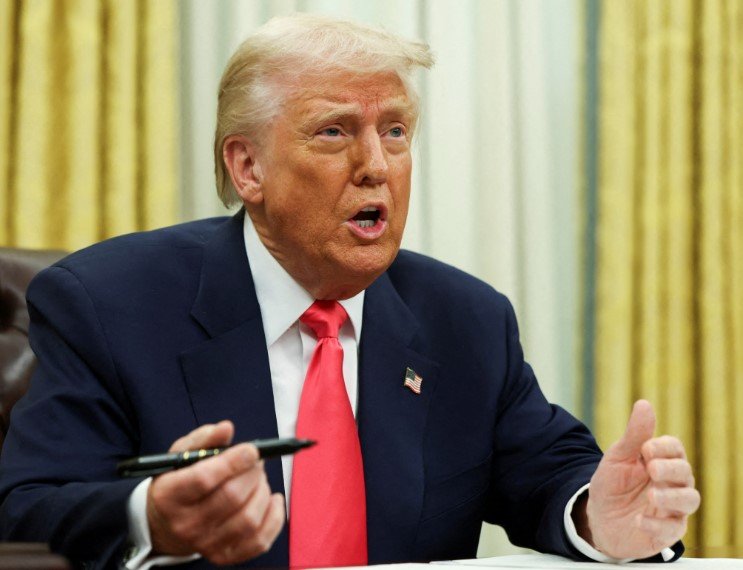Vice President JD Vance broke a nail-biter tie in the Senate to push through Trump’s defining economic bill—one that rewrites tax rules, slashes safety nets, and raises the debt limit by an eye-popping $5 trillion. Critics call it reckless. Supporters call it historic.
The U.S. Senate passed a sweeping $3.3 trillion tax and spending package late Tuesday night, after hours of high-stakes floor drama and partisan brinkmanship that climaxed with Vice President JD Vance casting a rare tie-breaking vote. Dubbed the “One Big Beautiful Bill,” the legislation touches nearly every major piece of America’s fiscal machinery—from taxes to healthcare to border policy to the federal debt ceiling.
The bill now returns to the House of Representatives, where final approval is expected later this week, largely along party lines.
President Donald Trump, in a brief late-night social media post, called it “the greatest tax and economic bill ever passed—maybe anywhere,” while Democrats denounced it as a “cynical attempt to buy votes while gutting support for the poor.”
Let’s unpack what’s inside.
Tax Cuts That Never Expire
At the heart of the bill lies a massive extension—and expansion—of the 2017 Trump tax cuts, originally set to sunset in 2025.
Those individual and corporate tax breaks are now permanent. Wealthier Americans will continue enjoying reduced top rates, while middle-income families will see modest benefits. The bill also expands business deductions and lowers the estate tax threshold even further.
In the words of Senator Rick Scott, “this locks in the economic boom we started.”
Not everyone agrees.
Critics, including some moderate Republicans, worry the long-term costs will balloon federal debt without driving enough new growth to compensate. But in an election year, political calculus won the day.

Where the Ax Falls: Medicaid, SNAP, and More
To offset a portion of the cost, the bill calls for roughly $1.2 trillion in cuts and “savings” over the next ten years—most of it targeting federal aid programs.
That includes:
-
$590 billion reduction in Medicaid federal matching funds
-
$280 billion trimmed from the Supplemental Nutrition Assistance Program (SNAP)
-
$90 billion shaved off Section 8 housing assistance
One senator quipped, “It’s Robin Hood in reverse.”
Supporters argue these reforms tighten eligibility loopholes and push more Americans into employment. Critics say the bill effectively punishes the poor and disabled to make room for corporate gains.
A Border Wall by Another Name
The legislation also includes a suite of immigration provisions that amount to the toughest clampdown in decades. One measure redirects $80 billion in discretionary funds to expand detention capacity, increase deportation courts, and deploy advanced surveillance tech along the southern border.
A new fast-track removal authority has also been created, allowing expedited deportations for undocumented immigrants arrested within 500 miles of the border.
One GOP aide was blunt: “This is the wall Trump always wanted—without the concrete.”
The Eye-Watering Debt Ceiling Jump
Then there’s the headline number: $5 trillion. That’s the new cap for U.S. borrowing, lifting the debt ceiling to a record $39 trillion through 2030.
The Congressional Budget Office (CBO) estimates the bill itself will add $3.3 trillion to the deficit over the next decade—much of it front-loaded due to the tax extensions and immediate spending increases.
Here’s a breakdown of key figures:
| Category | Amount (USD) |
|---|---|
| Tax Cut Extensions | $4.5 trillion |
| Offsets via Cuts/Savings | $1.2 trillion |
| Net Addition to Debt (10 years) | $3.3 trillion |
| New Debt Ceiling Limit | $39 trillion |
Senator Elizabeth Warren didn’t mince words. “This bill sells out working families to benefit billionaires and hedge funds,” she said.
House Democrats Fume, But Are Outnumbered
The bill now heads back to the House, where Republicans have a slim majority. Though procedural hurdles remain, it’s likely to pass.
Still, the debate has drawn sharp lines. Democratic House Leader Hakeem Jeffries accused the GOP of “torching the federal safety net to appease Wall Street donors.”
That said, a few centrist Democrats from swing districts might quietly support certain tax provisions. They won’t say so publicly—at least not yet.
Political Gamble Ahead of November
Make no mistake: this bill is as much a political statement as it is policy. Trump is betting big on kitchen-table economics to shore up his base ahead of the November election.
By making his 2017 tax cuts permanent, he’s locking in a legacy—and giving his campaign a punchy talking point.
But it’s risky.
The backlash over Medicaid and SNAP cuts is already fierce. Healthcare activists have launched ads in battleground states warning of “life-or-death consequences.”
Meanwhile, fiscal hawks who once cried foul over Obama-era stimulus packages have gone quiet—some Democrats call it hypocrisy, others call it pure politics.
Vance’s Tiebreaker Moment
The Senate vote was 50-50 until Vice President JD Vance, presiding in his role as Senate President, cast the deciding vote—his first since taking office in January.
He delivered it with a simple, “Aye,” before rising and shaking hands with Senate Majority Leader Steve Daines.
Online, the clip went viral within minutes.
One comment read: “JD Vance just cast the most expensive vote in U.S. history.”
Wall Street Reacts With a Shrug
Interestingly, markets barely flinched. The Dow closed up 112 points Tuesday, and the yield on 10-year Treasuries nudged slightly higher.
Investors had largely priced in the bill’s passage.
Analysts say the permanent tax relief is seen as pro-growth by the markets, even if it adds to long-term fiscal worries.
Still, there’s one concern that looms large: inflation.
If stimulus hits too hard, too fast, and consumers flood the economy with spending again, the Federal Reserve may be forced to keep interest rates elevated well into 2026.
For now though, Wall Street’s watching—quietly.
